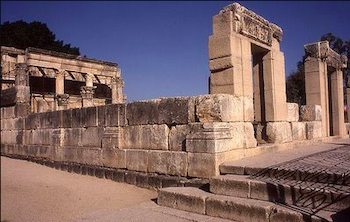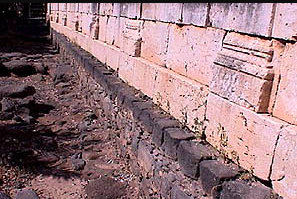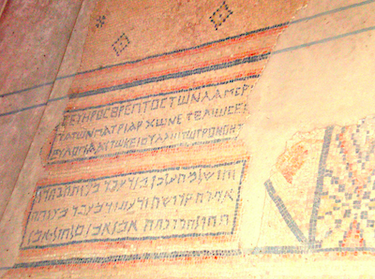The Palestinian Talmud mentions that Huqoq is known for its mustard production. Could the mustard industry have been profitable enough to provide the village’ prosperity?
See Also: What the Gospels Left Out
By Paul V.M. Flesher
Director
Religious Studies Program
University of Wyoming
August 2012
Huqoq, the ancient Galilean village, has been in the international news. The team announced the discovery of two parts of a mosaic synagogue floor: a scene of the biblical hero Samson and a Hebrew inscription with the heads of women on either side. (See the links below.) It is dated to roughly the fourth to sixth century.
This is quite an impressive find because the mosaic is of high artistic quality. The artist was able to incorporate many colors and much detail because he/she used tiny tesserae, smaller than those in most mosaics constructed at this time around the Mediterranean Sea.
What does it take to discover such artwork? In Huqoq’s case, it takes a small expedition, whose members undertake daily hard and pain-staking work. Several dozen people, both staff and students, were in the field for a month, and while there, they needed transportation, regular meals and gallons of water, housing, as well as the necessary equipment to support the work.
This scientific expedition was planned, organized, and led by Jodi Magness of the University of North Carolina at Chapel Hill, closely assisted by David Amit and Shua Kisilevitz of the Israel Antiquities Authority. Several other universities helped sponsor the excavations, from the University of Oklahoma and Brigham Young University to the University of Toronto. The students from North America and Europe who participated earned college credit while learning proper excavation techniques, from trowel and wheelbarrow handling to the intensive measuring, identification and recording that accompanies even the smallest finds.
So what’s the payoff for all this time, work and expense? If we believed the Indiana Jones movies, then the goal would be either to acquire important artifacts for a museum (to display human heritage) or for treasure hunting (stealing people’s heritage). In addition, the Internet reveals some groups aim to set out to discover objects to “prove the Bible,” such as recent attempts to find Noah’s ark. The first goal is incorrect—artifacts belong to the country of origin rather than the finder—and the latter two are usually fraudulent at best.
But for archaeology carried out in a scientific manner, the goal is understanding the human past. And understanding comes from interpreting the finds within their archaeological context, namely, that of ancient people and their activities, lives, accomplishments and beliefs.
The excavations that took place provided such a context, for in addition to the synagogue, excavations were also done in the housing area of the ancient village. This work provided insight into the villagers’ life style.

Possibly contemporaneous
with Huqoq synagogue, 4th-
6th century CE.
The synagogue indicates the village was prosperous at the time of its erection. Not only do the mosaic’s tiny tesserae point to its quality and expense, but so do the massive, shaped stones that make up the synagogue’s walls.1 There is nothing small about its construction.
A bit of historical context is provided by a contemporary book; the Palestinian Talmud mentions that Huqoq is known for its mustard production. Could the mustard industry have been profitable enough to provide the village’s prosperity? Perhaps. Spices can be expensive.

The stone blocks making up
the walls of Capernaum's
contemporary synagogue
are large like those of the
Huqoq synagogue.
Or maybe we should expand our horizon and view Huqoq within the context of surrounding villages. Many of the nearby synagogues of this era also show evidence of affluence. Capernaum, Chorazin, Hamat Tiberias and Wadi Hamam immediately come to mind, either because of their mosaics or their massive stone construction. Perhaps the Jewish villages around the Sea of Galilee were generally prosperous, rather than impoverished, which enabled them to build monumental synagogues.

Tiberias. Other synagogues
near Huqoq had mosaic
floors as well.
That would be an interesting conclusion, for the sixth century is the time of the Byzantine Emperor Justinian I. He was a powerful ruler famed for compiling an extensive law code, In that code, he outlawed pagan religions and forbade Jews from building new synagogues, although they could remodel old ones. The monumental synagogues of Huqoq and surrounding villages perhaps show that Justinian’s law was not being followed in Galilee. His control apparently did not extend to the Galilean interior.
The scientific archaeological excavations at the village of Huqoq, then, provide important insight into the lives of ancient Galilean Jews, as well as help us evaluate the power and effectiveness of one of the most important rulers in the ancient world.
Note: News on the Huqoq finds appears at: CNN, Israel National News, MSNBC.
Notes
1 For a discussion of the Huqoq synagogue wall, see Jodi Magness’s article, “Huqoq — 2011, Preliminary Report,” in Hadashot Arkheologiyot, vol. 124 (29/3/2012) at http://www.hadashot-esi.org.il/report_detail_eng.asp?id=
1959&mag_id=119. Image 6 shows two courses of the synagogue wall, the upper one fallen.
